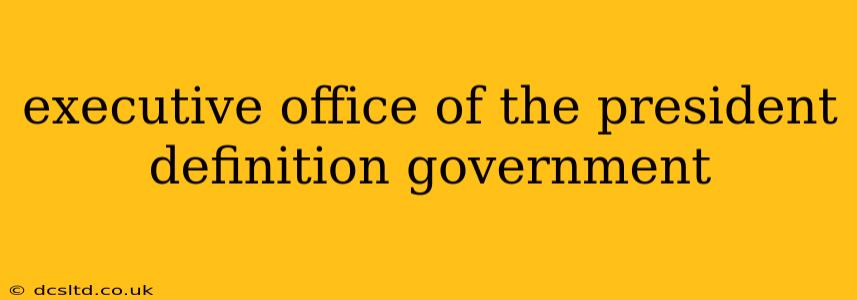The Executive Office of the President (EOP) is a group of agencies and offices that directly support the President of the United States in carrying out their responsibilities. It's not a single entity but rather a collection of organizations working together to help the President manage the vast complexities of the executive branch and formulate national policy. Unlike the Cabinet departments, which have specific areas of responsibility (like Defense or Education), the EOP is focused on assisting the President in their overall duties. Think of it as the President's inner circle, providing vital advice, support, and operational capacity.
What Does the Executive Office of the President Do?
The EOP's roles are multifaceted and incredibly important to the functioning of the U.S. government. Its primary functions include:
-
Policy Development and Advice: Agencies within the EOP, like the Council of Economic Advisers (CEA) and the Office of Management and Budget (OMB), provide crucial analysis and recommendations on a wide range of policy issues, from economic forecasts to budgetary decisions. This ensures the President has access to expert opinions before making critical decisions.
-
Operational Support: The EOP manages many of the President's daily operations, including scheduling, communications, and staff support. This allows the President to focus on strategic matters, rather than getting bogged down in administrative details.
-
Interagency Coordination: The EOP plays a critical role in coordinating activities across different government agencies. This ensures that various departments work together harmoniously to achieve common goals. This is particularly important for complex issues requiring a multi-agency approach.
-
Communication and Public Relations: The EOP is involved in managing the President's public image and communicating their policies and actions to the American people. This includes press briefings, speeches, and other forms of communication.
Key Agencies Within the Executive Office of the President
Several prominent agencies fall under the EOP umbrella. Understanding their individual functions clarifies the overall scope of the EOP:
-
Office of Management and Budget (OMB): This is arguably the most influential agency within the EOP. The OMB is responsible for preparing the President's annual budget proposal, managing federal spending, and overseeing the performance of government agencies.
-
Council of Economic Advisers (CEA): The CEA provides the President with expert advice on economic matters, conducting economic analysis and forecasting, and developing recommendations for economic policy.
-
National Security Council (NSC): The NSC is responsible for advising the President on national security and foreign policy issues. It coordinates the activities of various agencies involved in national security.
-
White House Office: This is the President's immediate staff, including senior advisors, speechwriters, and press secretaries. It handles the President's daily schedule and communications.
How is the Executive Office of the President Structured?
The EOP is structured to provide efficient support to the President. The structure is fluid and can change based on the President's priorities and preferences. However, the core agencies remain consistent in their overall function. The President has considerable authority in shaping the EOP to meet their needs.
What is the difference between the Executive Office of the President and the Cabinet?
This is a frequently asked question. While both support the President, they differ significantly in their roles:
-
Cabinet Departments: These are large, independent government departments with specific areas of responsibility (e.g., Department of Defense, Department of Education). Cabinet secretaries are appointed by the President and confirmed by the Senate.
-
Executive Office of the President: This is primarily focused on supporting the President directly in policy formulation, implementation, and day-to-day operations. The agencies within the EOP advise and assist the President, rather than having independent areas of responsibility like the Cabinet departments.
Understanding the Executive Office of the President is crucial to grasping the complexities of the U.S. government. Its role in advising, coordinating, and supporting the President is essential for effective governance.
